It looks like you're using an Ad Blocker.
Please white-list or disable AboveTopSecret.com in your ad-blocking tool.
Thank you.
Some features of ATS will be disabled while you continue to use an ad-blocker.
share:
originally posted by: beansidhe
Is that you in the hat?
Of course. Who else would it be?
I'd always assumed you were hooved. (Not really)
I wear prosthetic shoes to hide them.
And what a beautiful red haired wife you have.
Thank you, I will pass along the compliment.
Wow, I'm not usually a huge fan of the Romans, but you can't argue with their artistic skills and masonry...
The architecture there is just stunning. Thanks so much for posting these, it's a part of Europe I've never been to and I'm one of the rare type of people who enjoys other folk's holiday photos!
It looks like you had a fantastic holiday, it must have felt good to be home.
B x
The architecture is very impressive. If the temples and structures were not scavenged of their travertine and marble for palaces and villas they would most likely still be standing.
It was a fantastic vacation and I am glad you liked the pictures, I will try to post more tomorrow.
edit on 29-8-2015 by AugustusMasonicus because: remember the Limelight
a reply to: AugustusMasonicus
I didn't like to assume, just in case it was simply an attractive bystander you liked the look of!
Yes, I loved the pictures and if you get a chance to post more that would be great. I love walking in the footsteps of ancient cultures; you can better understand their writing if you can see where they used to live, and the views they used to see.
I'll look forward to the rest of your photos,
B x
I didn't like to assume, just in case it was simply an attractive bystander you liked the look of!
Yes, I loved the pictures and if you get a chance to post more that would be great. I love walking in the footsteps of ancient cultures; you can better understand their writing if you can see where they used to live, and the views they used to see.
I'll look forward to the rest of your photos,
B x
originally posted by: beansidhe
I didn't like to assume, just in case it was simply an attractive bystander you liked the look of!
Flattery will in fact get you every where.
Yes, I loved the pictures and if you get a chance to post more that would be great. I love walking in the footsteps of ancient cultures; you can better understand their writing if you can see where they used to live, and the views they used to see.
I'll look forward to the rest of your photos...
I think you will like the next ones then, they are all in the Roman and Imperial Forums, the Colosseum and some from The Capitoline Museum.
Our continuing exploration of Rome's Centro Storico brought us to its most historic sites, ones that have been standing for 2,000 years and longer.
There is an overwhelming sense of history as you descend towards what was once the center of Roman life, politics, society and culture. One of the first sites you see is the towering Column of Trajan which recounts the Empire's conquest of Dacia and is told pictographically in a carved marble scroll the winds up to the pinnacle. Originally topped by a bronze of Trajan it now holds Saint Peter:

You are next drawn to the mammoth Forum of Trajan, the largest of the Imperial Forums. It was at the time one of the largest civil engineering works ever undertake and required excavating parts of the Capitoline and Quirinal Hills. It is also the first example of mixed use structures with retail/workshops on the ground floors and upper stories where the merchants and their families would have resided. The great Apollodorus was the architect:

Looking west towards Trajan's Column and the Vittorio Emanuele II Monument:

The Forum is split by a modern, arched street, this is the north side looking east:

South side looking west:

The north side looking west where you can see the steps leading to the former portico:

And the south looking east which backs up onto the Foro Romano:
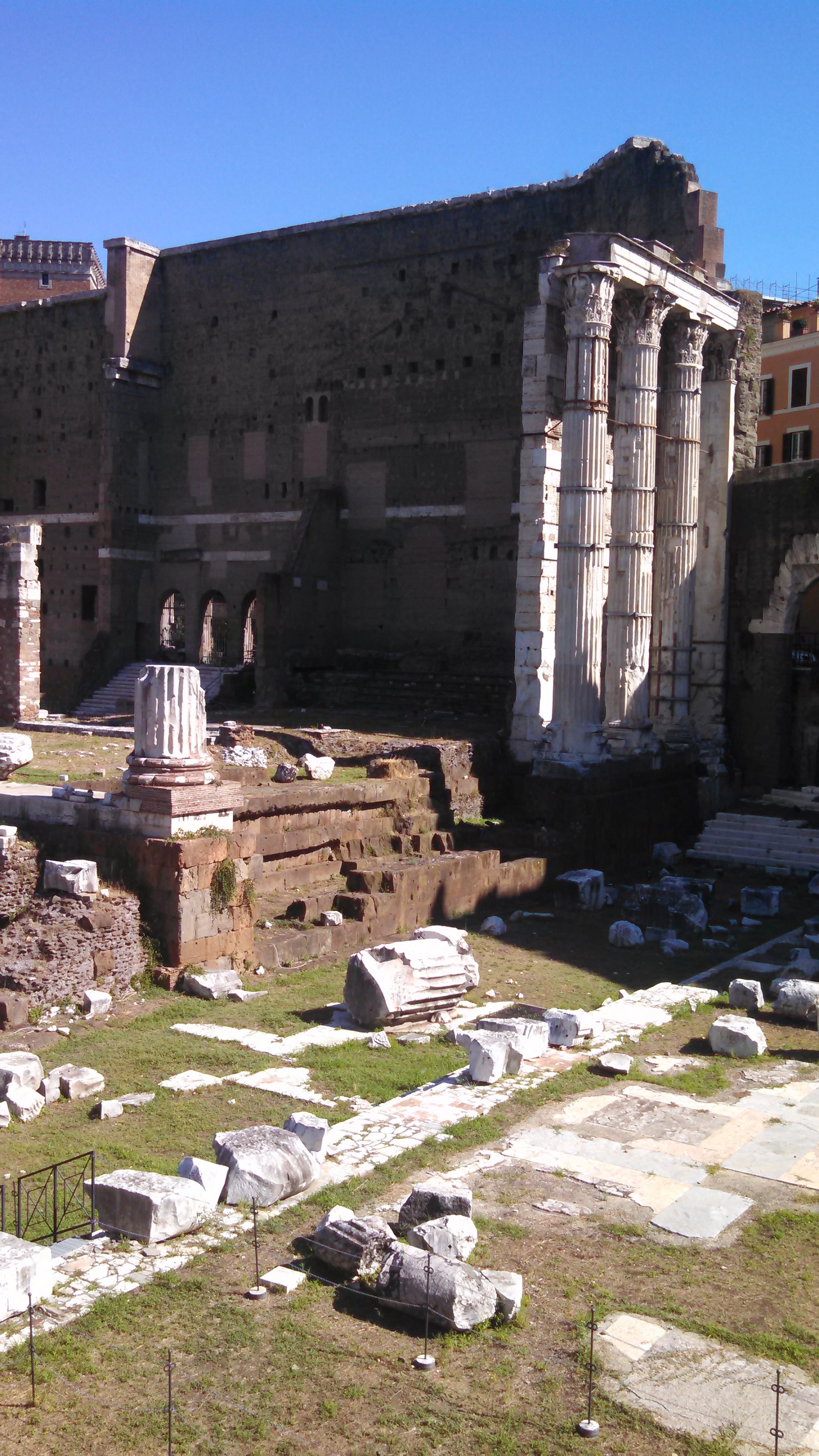
The next of the Imperial Forae is that of Augustus. It was adjacent ot his Grand Uncle's, Julius Caesar and lays between the Foro Romano and that of Trajan. Here is a view looking west towards the Capitoline Hill:

In this shot you can see the much smaller Forum of Caesar behind that of Augustus. Caesar's Forum was the first forum built outside of the original Roman Forum which had existed for over 500 years by that point:

This is a picture looking south towards the Palatine Hill and gives you a great perspective on how high that hill is even today. It was once the site of the imperial palaces and is where we get the name 'palace' itself:

The next stop is the most famous of all of Rome's landmarks and is visited by over 6,000,000 people each year, the Colosseum. Built on the grounds of Nero's Domus Aurea, or Golden House, its actual name is the Flavian Amphitheater named after the Emperor Vespasian Flavianus and his two sons, Titus and Domitian, who undertook the construction using the spoils from the sack of Jerusalem. Its name is taken from the Colossus of Nero which once stood adjacent to the Colosseum and saw his head replaced with that of Helios.
Built in only 10 years it could hold over 50,000 Romans, who did not pay to enter, and would host games from morning until dusk, sometimes in festivals lasting over 100 days. Seating was assigned and the Colosseum had architectural innovations we use to this day, including a retractable roof.
It looms over your view when coming down the Via dei Fori Imperialii and no picture is really able to capture its monumental scale:


The road is above the former street level and affords a great view of both the Colosseum and the Arch of Constantine:

It also provides a great view of the upper stories of the Colosseum. Notice the projecting brackets at the top, these were used to hold the masts that the Valarium, or closing roof, would be anchored on. The entire system was operated by 1,000 Imperial Navy seamen who would often times use the ropes to dramatically swing down to arena-level before looping back up to the roof:

The interior of the Colosseum is just as impressive as the exterior and, due to a good portion of the marble facing being removed, you are able to view the inner support structure. In some areas the marble still remains and interesting finds are on display.
Contrary to popular belief most gladiatorial matches were not to the death as the athletes were very expensive to train, house, feed and equip. Additionally, as they continued to amass victories, they became incredibly popular, much like modern day athletes, and even had their own fan clubs. In the below picture is a topless Amazon (her partner was off to the left) and their trained pet tiger. The tiger is wearing a good luck charm. Sadly, the charm did not work as this is a memorial inlaid into the marble and paid for by their fan club:

Moving to the arena area you can easily take in the scope of the Colosseum, despite their being a good portion of the outer walls missing. These are from the second level, which is as high as you are permitted without special passes:




The last photo shows some of the continuously occurring restoration on the 2,000 year old edifice. Also of note in the second picture is a trap door. The curator of the Colosseum held a contest by reaching out to the major engineering universities in the world to see who could devise an actual functioning trap door system using the indentations and markings present in the Colosseum. Only one university was able to do this, the German Archeological Institute at Rome. Here is another angle:

The trap door reaches down into the hypogeum where hundreds of workers would toil in dark, hot, cramped and dangerous quarters using the 24+ lifts to hoist animals, people and scenery onto the arena floor for the beast hunts, executions, historical recreations and gladiatorial events. The hypogeum reaches over 20 feet underground and is labyrinthine in its layout:


Not everything was toil and drudgery, just like modern arenas there were preferred seats.
These are from the ground level and would have been for Equestrian and Patrician seating:


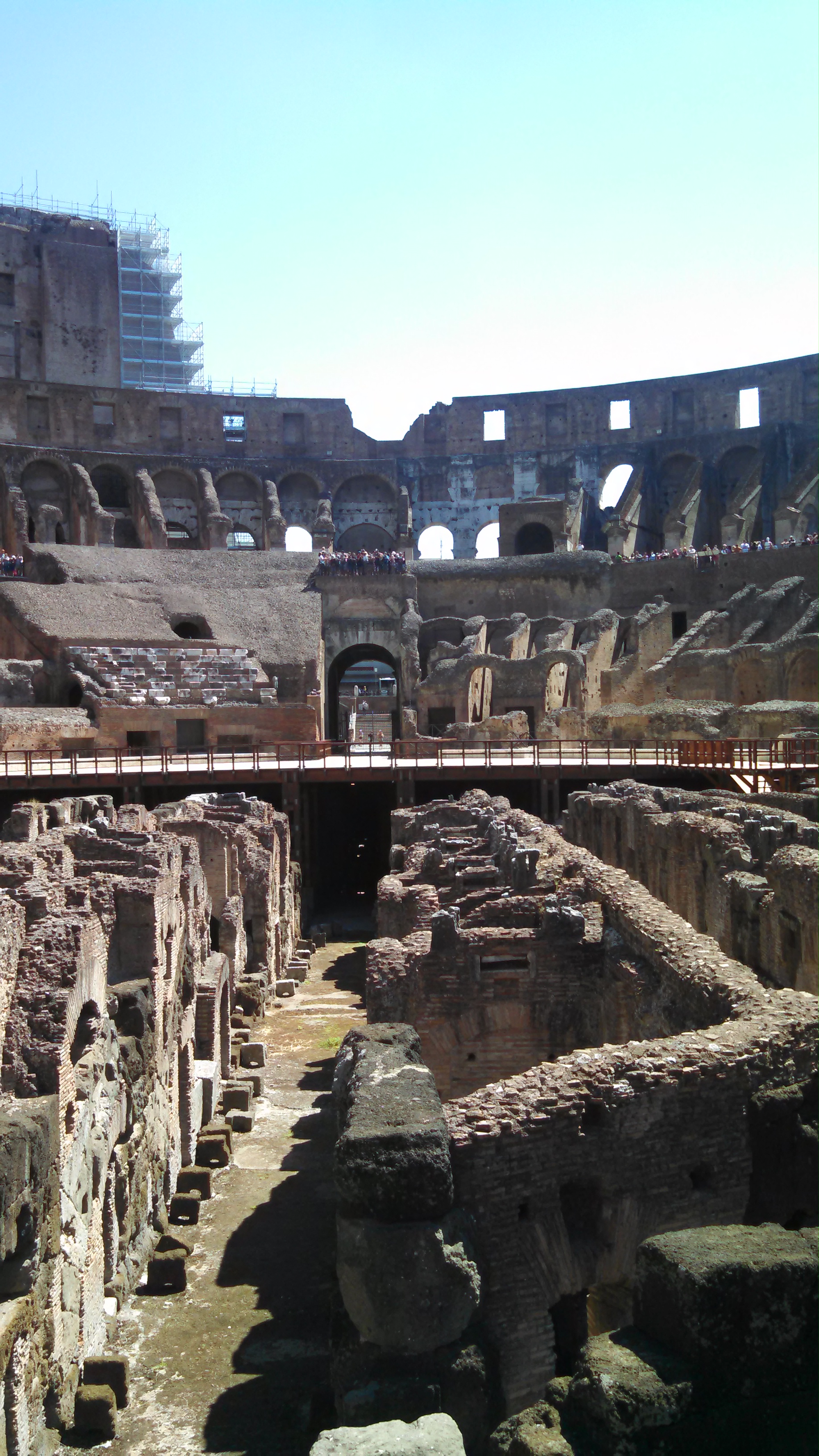

This is a view of the Senators seats, still with the marble intact:

The Vestal Virgin's box on the lower level:

And the Emperor's box:
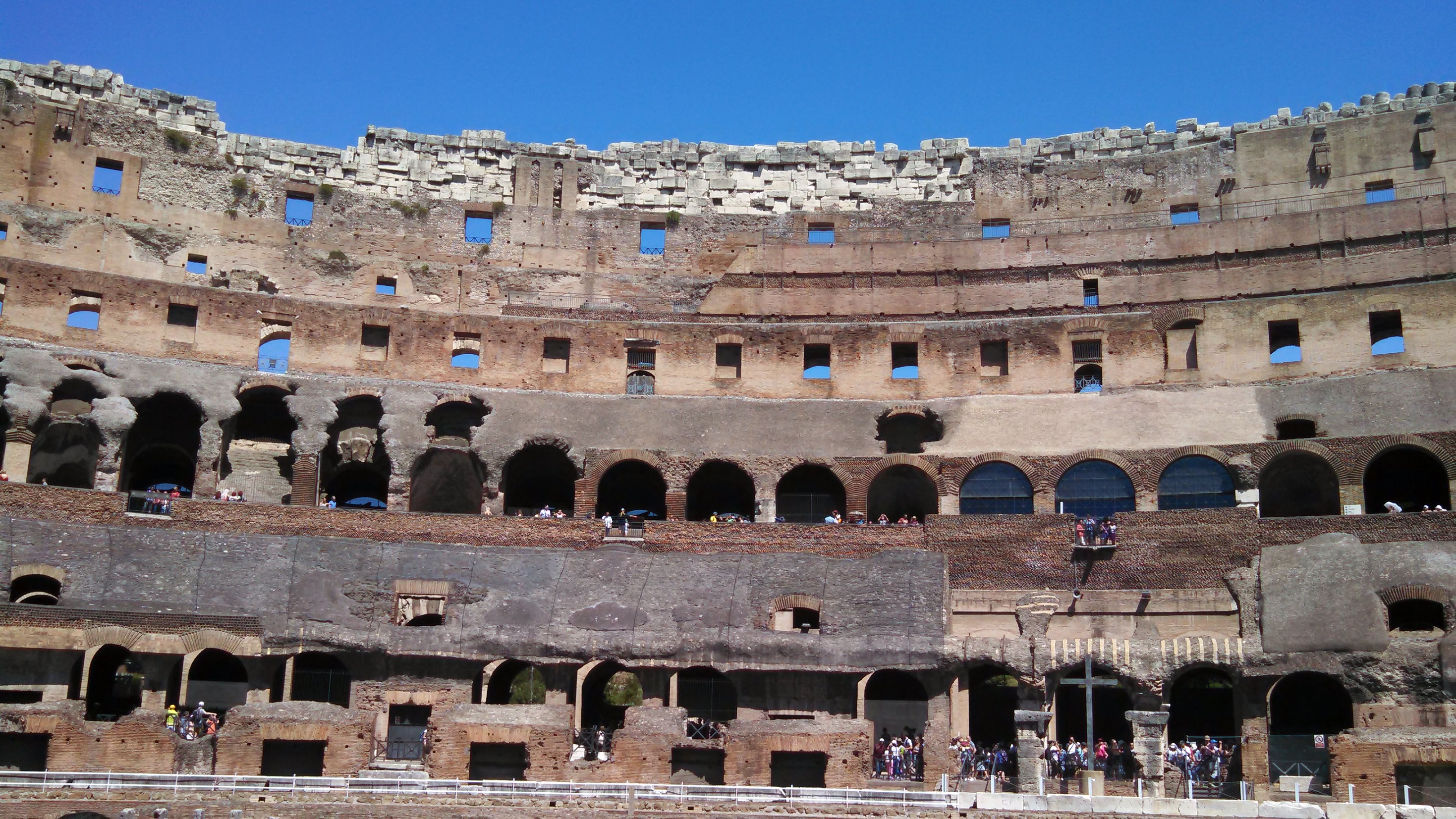
From the Colosseum you get a very good view of the Temple of Venus with the Church of Santa Francesca adjacent to it:

As well as the Arch of Constantine:

There is an overwhelming sense of history as you descend towards what was once the center of Roman life, politics, society and culture. One of the first sites you see is the towering Column of Trajan which recounts the Empire's conquest of Dacia and is told pictographically in a carved marble scroll the winds up to the pinnacle. Originally topped by a bronze of Trajan it now holds Saint Peter:

You are next drawn to the mammoth Forum of Trajan, the largest of the Imperial Forums. It was at the time one of the largest civil engineering works ever undertake and required excavating parts of the Capitoline and Quirinal Hills. It is also the first example of mixed use structures with retail/workshops on the ground floors and upper stories where the merchants and their families would have resided. The great Apollodorus was the architect:

Looking west towards Trajan's Column and the Vittorio Emanuele II Monument:

The Forum is split by a modern, arched street, this is the north side looking east:

South side looking west:

The north side looking west where you can see the steps leading to the former portico:

And the south looking east which backs up onto the Foro Romano:

The next of the Imperial Forae is that of Augustus. It was adjacent ot his Grand Uncle's, Julius Caesar and lays between the Foro Romano and that of Trajan. Here is a view looking west towards the Capitoline Hill:

In this shot you can see the much smaller Forum of Caesar behind that of Augustus. Caesar's Forum was the first forum built outside of the original Roman Forum which had existed for over 500 years by that point:

This is a picture looking south towards the Palatine Hill and gives you a great perspective on how high that hill is even today. It was once the site of the imperial palaces and is where we get the name 'palace' itself:

The next stop is the most famous of all of Rome's landmarks and is visited by over 6,000,000 people each year, the Colosseum. Built on the grounds of Nero's Domus Aurea, or Golden House, its actual name is the Flavian Amphitheater named after the Emperor Vespasian Flavianus and his two sons, Titus and Domitian, who undertook the construction using the spoils from the sack of Jerusalem. Its name is taken from the Colossus of Nero which once stood adjacent to the Colosseum and saw his head replaced with that of Helios.
Built in only 10 years it could hold over 50,000 Romans, who did not pay to enter, and would host games from morning until dusk, sometimes in festivals lasting over 100 days. Seating was assigned and the Colosseum had architectural innovations we use to this day, including a retractable roof.
It looms over your view when coming down the Via dei Fori Imperialii and no picture is really able to capture its monumental scale:


The road is above the former street level and affords a great view of both the Colosseum and the Arch of Constantine:

It also provides a great view of the upper stories of the Colosseum. Notice the projecting brackets at the top, these were used to hold the masts that the Valarium, or closing roof, would be anchored on. The entire system was operated by 1,000 Imperial Navy seamen who would often times use the ropes to dramatically swing down to arena-level before looping back up to the roof:

The interior of the Colosseum is just as impressive as the exterior and, due to a good portion of the marble facing being removed, you are able to view the inner support structure. In some areas the marble still remains and interesting finds are on display.
Contrary to popular belief most gladiatorial matches were not to the death as the athletes were very expensive to train, house, feed and equip. Additionally, as they continued to amass victories, they became incredibly popular, much like modern day athletes, and even had their own fan clubs. In the below picture is a topless Amazon (her partner was off to the left) and their trained pet tiger. The tiger is wearing a good luck charm. Sadly, the charm did not work as this is a memorial inlaid into the marble and paid for by their fan club:

Moving to the arena area you can easily take in the scope of the Colosseum, despite their being a good portion of the outer walls missing. These are from the second level, which is as high as you are permitted without special passes:




The last photo shows some of the continuously occurring restoration on the 2,000 year old edifice. Also of note in the second picture is a trap door. The curator of the Colosseum held a contest by reaching out to the major engineering universities in the world to see who could devise an actual functioning trap door system using the indentations and markings present in the Colosseum. Only one university was able to do this, the German Archeological Institute at Rome. Here is another angle:

The trap door reaches down into the hypogeum where hundreds of workers would toil in dark, hot, cramped and dangerous quarters using the 24+ lifts to hoist animals, people and scenery onto the arena floor for the beast hunts, executions, historical recreations and gladiatorial events. The hypogeum reaches over 20 feet underground and is labyrinthine in its layout:


Not everything was toil and drudgery, just like modern arenas there were preferred seats.
These are from the ground level and would have been for Equestrian and Patrician seating:




This is a view of the Senators seats, still with the marble intact:

The Vestal Virgin's box on the lower level:

And the Emperor's box:

From the Colosseum you get a very good view of the Temple of Venus with the Church of Santa Francesca adjacent to it:

As well as the Arch of Constantine:

edit on 1-9-2015 by AugustusMasonicus because: networkdude non ha nessuna birra
After spending close to 2 hours exploring the Colosseum we began to make our way towards the Foro Romano. The first site is the impressive Arch of
Constantine, the largest triumphal arch in Roman history, and the model for many other triumphal arches that would follow like Paris's Arc di
Triomphe:

You next pass around (not through) the Arch of Titus. His father Vespasian went to Rome to take the Purple and left his son behind to conquer the rebellious Jews who refused to recognize the previous Emperor. He was successful and the plunder of the Second Temple is depicted as it is paraded down the Via Sacra to the Forum where it was then melted down and used to pay for the Colosseum's construction:

Proceeding down the Via Sacra to the main part of the Forum you have a great view of the remains of parts of the Imperial Palaces atop the Palatine Hill:

Just opposite from that vantage point is the gigantic Basilica of Constantine, begun by Maxentius, which he built after reuniting the Empire an upon his visit to Rome:

Next is the Mausoleum of Maxentius's son, Valerius Romulus, who drowned tragically in he Tiber while he was still a youth:

The next photo is of the Temple of the Vestals, both front and back:


And the interior of their Temple, with its garden and portico:

The Vestal Virgins were the only Roman citizens permitted to reside within the Forum itself as they were charged with maintaining the Sacred Flame and the last wills and testaments of all Romans.
Looking west from their temple you have a good view of the remains of the Temple of Saturn with Rome's contemporary municipal building in the background (the Mayor's office is the top left window):

The same view taking in the Arch of Septimius Severus. In the background you can see the quadrigga on the Vittorio Emanuele Memorial, each triumphal arch would have had one of its own as well:

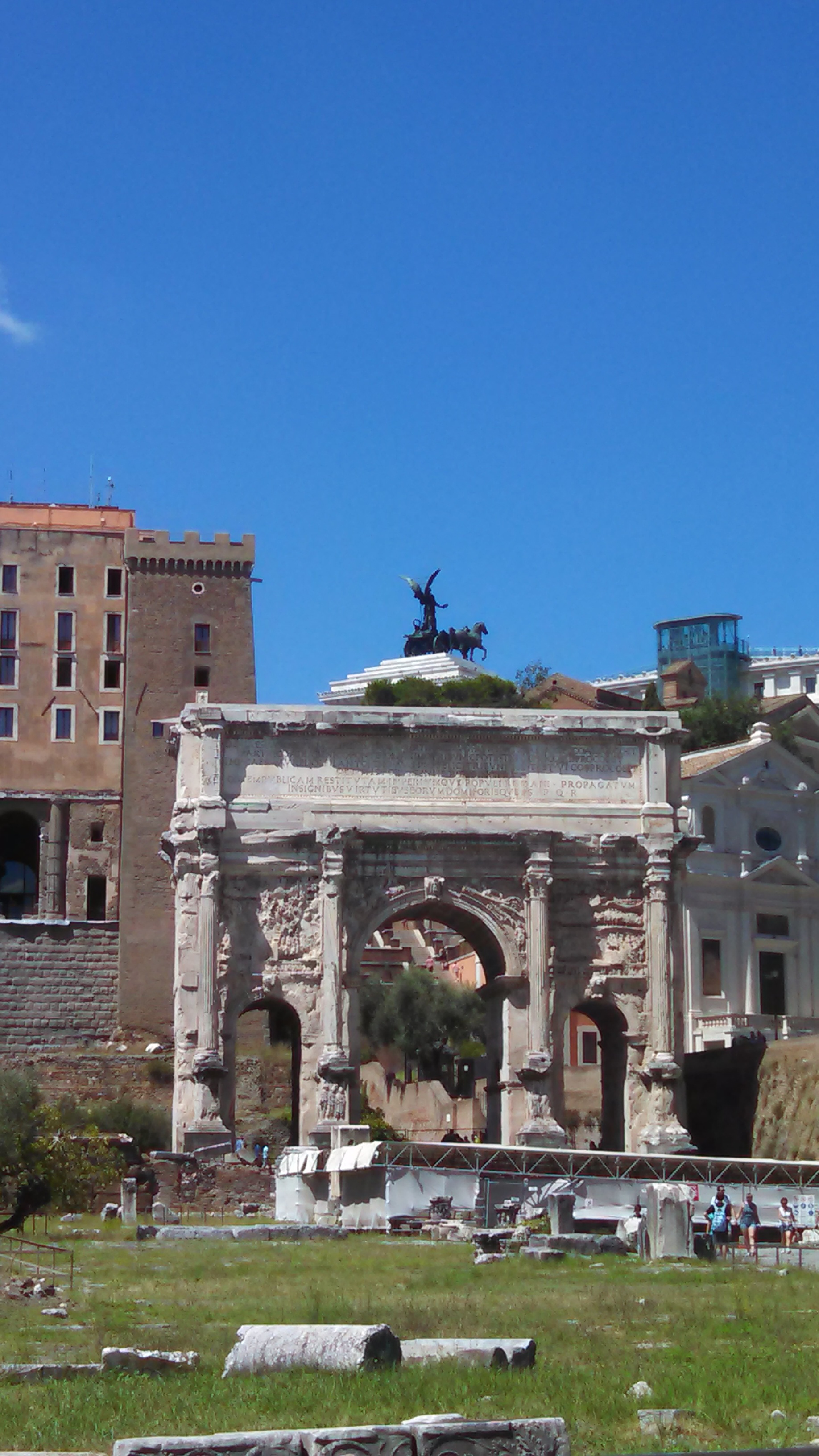
And looking up at the still-impressive palaces atop the Palatine Hill:

Next if the only fully intact structure in the Forum that dates from the pre-Imperial era, the Curia, or Senate House. Here, Roman Senators would meet to debate the key issues of the day and then walk out into the Forum to mingle with their patrons. Contrary to popular belief, Julius Caesar was not murdered here. That took place on the other side of the Capitoline Hill at the Theater of Pompey in what is now the Jewish Quarter:

After walking the Forum we climbed the Palatine Hill for unsurpassed views of the Forum and Rome. This is from the back side of the hill, with the Circus Maximus behind you, looking southwest towards the Capitoline and Quirinal Hills:

From the front you take in an amazing view of the Colosseum to the east:

The central part of the Forum:


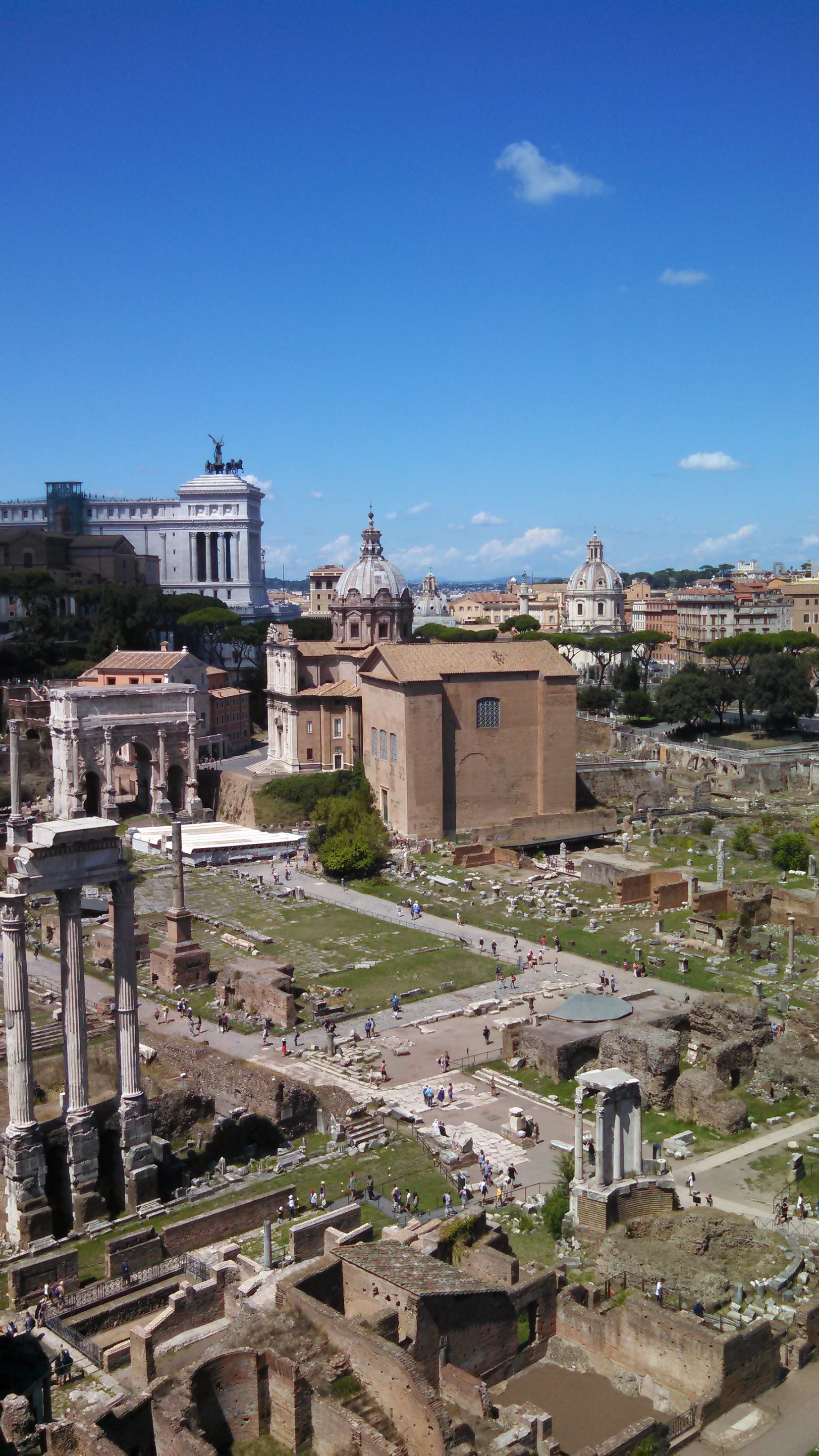
And then panning towards the Capitoline Hill:


Where you able to recognize the sites we saw earlier form up here? Pay attention to the last photo with the three huge arch ways under the municipal building, those are the remains of the Tabularium.

You next pass around (not through) the Arch of Titus. His father Vespasian went to Rome to take the Purple and left his son behind to conquer the rebellious Jews who refused to recognize the previous Emperor. He was successful and the plunder of the Second Temple is depicted as it is paraded down the Via Sacra to the Forum where it was then melted down and used to pay for the Colosseum's construction:

Proceeding down the Via Sacra to the main part of the Forum you have a great view of the remains of parts of the Imperial Palaces atop the Palatine Hill:

Just opposite from that vantage point is the gigantic Basilica of Constantine, begun by Maxentius, which he built after reuniting the Empire an upon his visit to Rome:

Next is the Mausoleum of Maxentius's son, Valerius Romulus, who drowned tragically in he Tiber while he was still a youth:

The next photo is of the Temple of the Vestals, both front and back:


And the interior of their Temple, with its garden and portico:

The Vestal Virgins were the only Roman citizens permitted to reside within the Forum itself as they were charged with maintaining the Sacred Flame and the last wills and testaments of all Romans.
Looking west from their temple you have a good view of the remains of the Temple of Saturn with Rome's contemporary municipal building in the background (the Mayor's office is the top left window):

The same view taking in the Arch of Septimius Severus. In the background you can see the quadrigga on the Vittorio Emanuele Memorial, each triumphal arch would have had one of its own as well:


And looking up at the still-impressive palaces atop the Palatine Hill:

Next if the only fully intact structure in the Forum that dates from the pre-Imperial era, the Curia, or Senate House. Here, Roman Senators would meet to debate the key issues of the day and then walk out into the Forum to mingle with their patrons. Contrary to popular belief, Julius Caesar was not murdered here. That took place on the other side of the Capitoline Hill at the Theater of Pompey in what is now the Jewish Quarter:

After walking the Forum we climbed the Palatine Hill for unsurpassed views of the Forum and Rome. This is from the back side of the hill, with the Circus Maximus behind you, looking southwest towards the Capitoline and Quirinal Hills:

From the front you take in an amazing view of the Colosseum to the east:

The central part of the Forum:



And then panning towards the Capitoline Hill:


Where you able to recognize the sites we saw earlier form up here? Pay attention to the last photo with the three huge arch ways under the municipal building, those are the remains of the Tabularium.
We then headed out of the Forum and on top of the Capitoline Hill to visit the Capitoline Museum. Caput means 'head' in Latin and the Capitoline was
the head of Rome, it where we get our word for capitol from. It was the site of the Temples of Jupiter, Juno and Minerva, Rome's 'Triad'.
Outside of the museum is an equestrian statue of Marcus Aurelius, it is not original, but was made by Michelangelo during the Renaissance when the moribund Capitoline Hill was revitalized for the coming centuries:

The museum contains many marble busts and statues dating from the Republican and Principate Eras, the most notable among them are the Capitoline Wolf, the legendary she-wolf that nursed the twins who, the epics say, founded the city of Rome:

An amazingly intact bust of Medusa:

And an actual Roman Legionary Eagle:
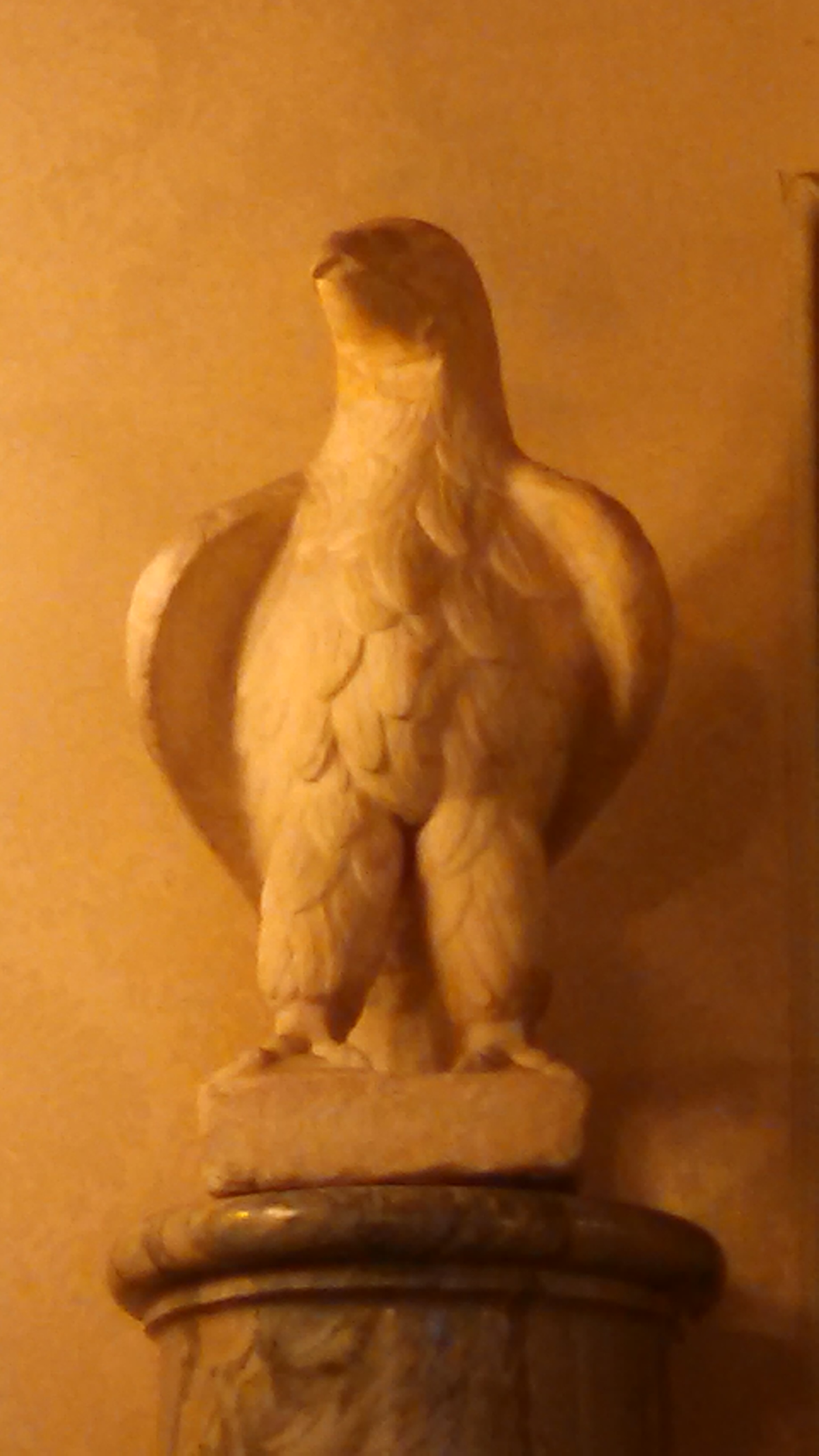
Inside also resides the original equestrian statues of Marcus Aurelius the Michelangelo copied, it is still in fantastic shape and you get a better idea of the size when it is not on a pedestal:
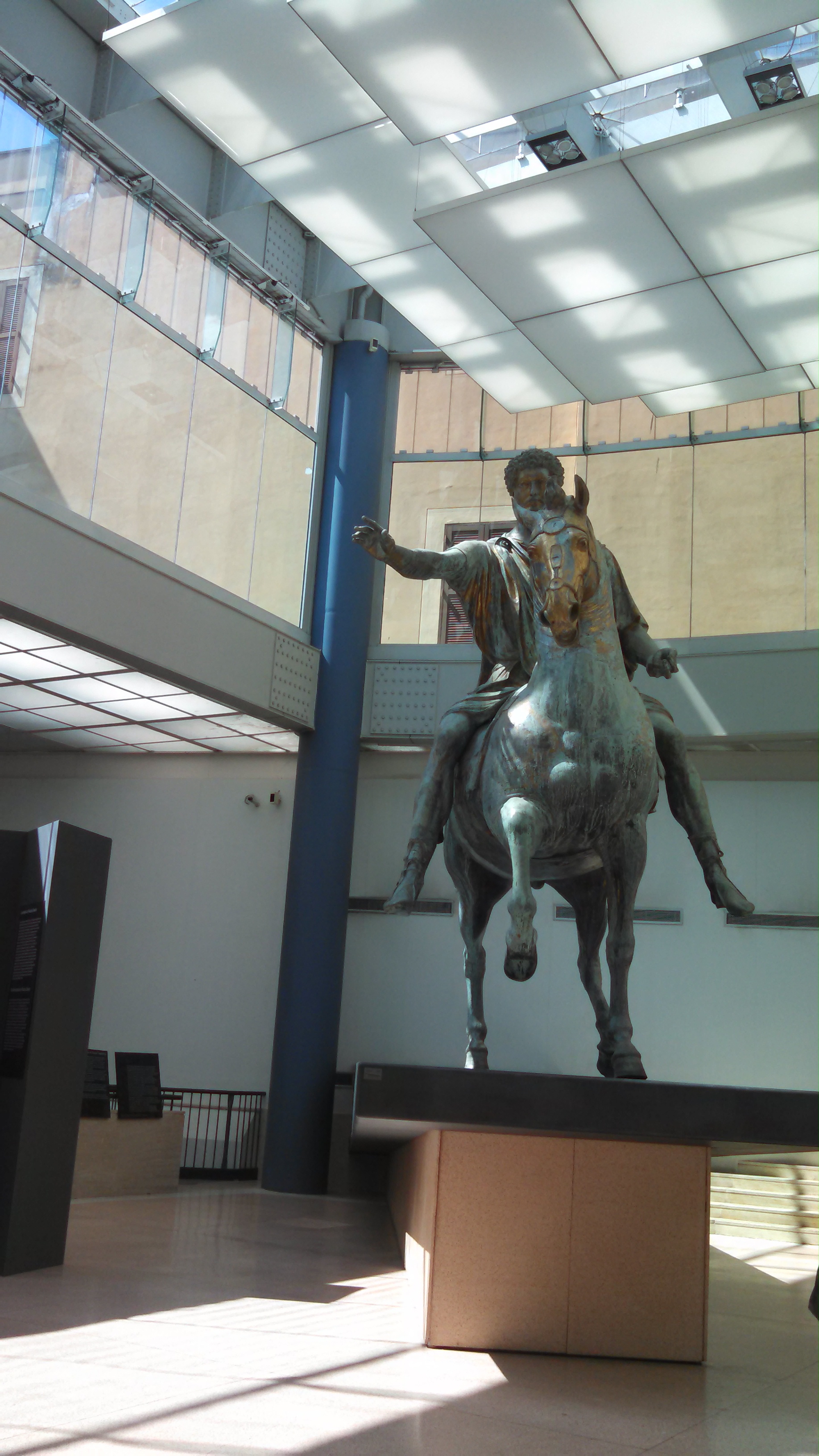
Also here are the original foundations to the Temple of Jupiter Optimus Maximus, Rome's chief deity. The foundations date back beyond 500BCE and in some areas still support the modern structures above:

We headed to the subterranean level and across to visit the Tabularium to capture some last, and possibly best, photos of the Forum from a rare perspective. The Arch of Severus:

Looking down the Forum:

And the Temples of Saturn and Vespasian:

That concluded our sightseeing trip in Italy and, after grabbing some authentic Roman pizza, we headed back to the hotel to relax on the pool deck. The next day we spent in Rome's premier shopping district, the Piazza di Spagna and the Via del Condotti where every high end fashion designer has an outpost. Here is a view from the top of the Spanish Steps:

We took advantage of the fantastic exchange rate and grabbed some gifts for our friends who were kind enough to watch our dogs while we were gone and for the wifey. Remember fellas, chicks dig Italian fashion:


The next day we took the long plane ride back to the United States with a tremendous amount of unique memories and experiences which neither one of us will forget. I encourage anyone who can to visit Italy at least once and make your own adventures and memories, it is well worth it. As I type this my wife is already asking to plan our next trip.
I hope you enjoyed this mini-travelogue, the stories and pictures. Please feel free to ask any questions you like and I will do my best to answer them.
Outside of the museum is an equestrian statue of Marcus Aurelius, it is not original, but was made by Michelangelo during the Renaissance when the moribund Capitoline Hill was revitalized for the coming centuries:

The museum contains many marble busts and statues dating from the Republican and Principate Eras, the most notable among them are the Capitoline Wolf, the legendary she-wolf that nursed the twins who, the epics say, founded the city of Rome:

An amazingly intact bust of Medusa:

And an actual Roman Legionary Eagle:

Inside also resides the original equestrian statues of Marcus Aurelius the Michelangelo copied, it is still in fantastic shape and you get a better idea of the size when it is not on a pedestal:

Also here are the original foundations to the Temple of Jupiter Optimus Maximus, Rome's chief deity. The foundations date back beyond 500BCE and in some areas still support the modern structures above:

We headed to the subterranean level and across to visit the Tabularium to capture some last, and possibly best, photos of the Forum from a rare perspective. The Arch of Severus:

Looking down the Forum:

And the Temples of Saturn and Vespasian:

That concluded our sightseeing trip in Italy and, after grabbing some authentic Roman pizza, we headed back to the hotel to relax on the pool deck. The next day we spent in Rome's premier shopping district, the Piazza di Spagna and the Via del Condotti where every high end fashion designer has an outpost. Here is a view from the top of the Spanish Steps:

We took advantage of the fantastic exchange rate and grabbed some gifts for our friends who were kind enough to watch our dogs while we were gone and for the wifey. Remember fellas, chicks dig Italian fashion:


The next day we took the long plane ride back to the United States with a tremendous amount of unique memories and experiences which neither one of us will forget. I encourage anyone who can to visit Italy at least once and make your own adventures and memories, it is well worth it. As I type this my wife is already asking to plan our next trip.
I hope you enjoyed this mini-travelogue, the stories and pictures. Please feel free to ask any questions you like and I will do my best to answer them.
edit on 9/13/2015 by Blaine91555 because: (no reason given)
a reply to: AugustusMasonicus
Wow!!!!! These photos are so amazing! Thanks again for sharing these!!!!!
You want to chuckle? In the last photo of your lovely wife, look behind at the two men. The way the lighting is, it looks like one is headless! Hahahaha!
Wow!!!!! These photos are so amazing! Thanks again for sharing these!!!!!
You want to chuckle? In the last photo of your lovely wife, look behind at the two men. The way the lighting is, it looks like one is headless! Hahahaha!
originally posted by: Night Star
Wow!!!!! These photos are so amazing! Thanks again for sharing these!!!!!
Glad you liked them.
You want to chuckle? In the last photo of your lovely wife, look behind at the two men. The way the lighting is, it looks like one is headless! Hahahaha!
I was about to post that in the Paranormal Forum but I belw the photo up and it's just a mannequin.
I spent 3 months in italy as a goatherder when I was young.
Put on 3 stone...loved it.
Glad you had a good time dude.
Put on 3 stone...loved it.
Glad you had a good time dude.
originally posted by: boymonkey74
I spent 3 months in italy as a goatherder when I was young.
I never met a professional goat herder, you need to supply details.
Glad you had a good time dude.
I had a great time but it was more for the wife who had never been there before.
a reply to: AugustusMasonicus
Goats are evil thats all you need to know.
Wife got any pals for when I come and visit btw?
Goats are evil thats all you need to know.
Wife got any pals for when I come and visit btw?
edit on 2-9-2015 by boymonkey74 because: (no reason given)
originally posted by: boymonkey74
Goats are evil thats all you need to know.
Wife got any pals for when I come and visit btw?
Maybe*...if I get the goat story posted here.
*Someone had a full scholarship to play volleyball at USC and still plays in leagues with some right fit chickies that frequently come over the house.
originally posted by: AugustusMasonicus
originally posted by: Night Star
Wow!!!!! These photos are so amazing! Thanks again for sharing these!!!!!
Glad you liked them.
You want to chuckle? In the last photo of your lovely wife, look behind at the two men. The way the lighting is, it looks like one is headless! Hahahaha!
I was about to post that in the Paranormal Forum but I belw the photo up and it's just a mannequin.
Hahahaha! I noticed that after I posted my reply. Funny all the same.
originally posted by: Night Star
Hahahaha! I noticed that after I posted my reply. Funny all the same.
You know what was really funny? He had a head when we got there...
originally posted by: AugustusMasonicus
originally posted by: Night Star
Hahahaha! I noticed that after I posted my reply. Funny all the same.
You know what was really funny? He had a head when we got there...
Oh my! Poor guy! LOL
originally posted by: Night Star
Oh my! Poor guy! LOL
They were dressing him and his coconut came off so they left in on a chair while they helped us.
It was kinda funny.
originally posted by: EvalynnAmbra
so amazing thanks for sharing this.
Glad you enjoyed them. Hopefully you have either seen some of the sights in person as well or you get there at some point.
Beautiful! Love, love love Italy! I'm trying to learn Italian right now.
Firenzi is my favorite!
One year we decided (on the 20th of December), that we didn't want to deal with the hassle of Christmas, so instead grabbed our kids and headed over to Italy. Spent 10 days travelling, in Tuscany, on the coast, down to Rome...it was awesome! Our kids were all in their teens at that time and it was the last family trip we all took together.

My youngest son dubbed this the Church of Too Much. LOL!
Thanks for sharing your awesome pictures and so much detailled descriptions!!
Firenzi is my favorite!
One year we decided (on the 20th of December), that we didn't want to deal with the hassle of Christmas, so instead grabbed our kids and headed over to Italy. Spent 10 days travelling, in Tuscany, on the coast, down to Rome...it was awesome! Our kids were all in their teens at that time and it was the last family trip we all took together.

My youngest son dubbed this the Church of Too Much. LOL!
Thanks for sharing your awesome pictures and so much detailled descriptions!!
new topics
-
The daily fail trying to imply “it’s aliens”
The Gray Area: 3 hours ago -
Swarms of tiny 'ant-like' robots lift heavy objects and navigate obstacles
Science & Technology: 5 hours ago -
NYPD Chief Jeffrey Maddrey Resigns - Forced Officers to Give Sex for Overtime Pay and Favors.
Posse Comitatus: 6 hours ago -
The Carpet Coating that Attacked the Environment
Medical Issues & Conspiracies: 10 hours ago -
Microplastics in your drinks
Medical Issues & Conspiracies: 11 hours ago
top topics
-
The Carpet Coating that Attacked the Environment
Medical Issues & Conspiracies: 10 hours ago, 11 flags -
China Working on 'Drone Mothership' Plane
Military Projects: 16 hours ago, 10 flags -
Microplastics in your drinks
Medical Issues & Conspiracies: 11 hours ago, 5 flags -
Happy Rush Day 2024 - 2112
Music: 16 hours ago, 4 flags -
NYPD Chief Jeffrey Maddrey Resigns - Forced Officers to Give Sex for Overtime Pay and Favors.
Posse Comitatus: 6 hours ago, 3 flags -
Swarms of tiny 'ant-like' robots lift heavy objects and navigate obstacles
Science & Technology: 5 hours ago, 2 flags -
The daily fail trying to imply “it’s aliens”
The Gray Area: 3 hours ago, 1 flags
active topics
-
'Mass Casualty event' - Attack at Christmas market in Germany
Mainstream News • 138 • : SprocketUK -
Just spotted an unusual aircraft Melbourne Australia
Aliens and UFOs • 8 • : andy06shake -
Microplastics in your drinks
Medical Issues & Conspiracies • 17 • : Dalamax -
Why isn't Psychiatry involved?
Social Issues and Civil Unrest • 29 • : GENERAL EYES -
An Interesting Conversation with ChatGPT
Science & Technology • 33 • : GENERAL EYES -
The daily fail trying to imply “it’s aliens”
The Gray Area • 1 • : BeyondKnowledge3 -
Swarms of tiny 'ant-like' robots lift heavy objects and navigate obstacles
Science & Technology • 2 • : BeyondKnowledge3 -
Post A Funny (T&C Friendly) Pic Part IV: The LOL awakens!
General Chit Chat • 7942 • : imitator -
Drones everywhere in New Jersey ---and Elsewhere Master Thread
Aliens and UFOs • 221 • : imitator -
Donald Trump Should Offer AMNESTY to the BIDEN FAMILY For Indicting Blackmailers-Controllers.
US Political Madness • 78 • : WeMustCare
